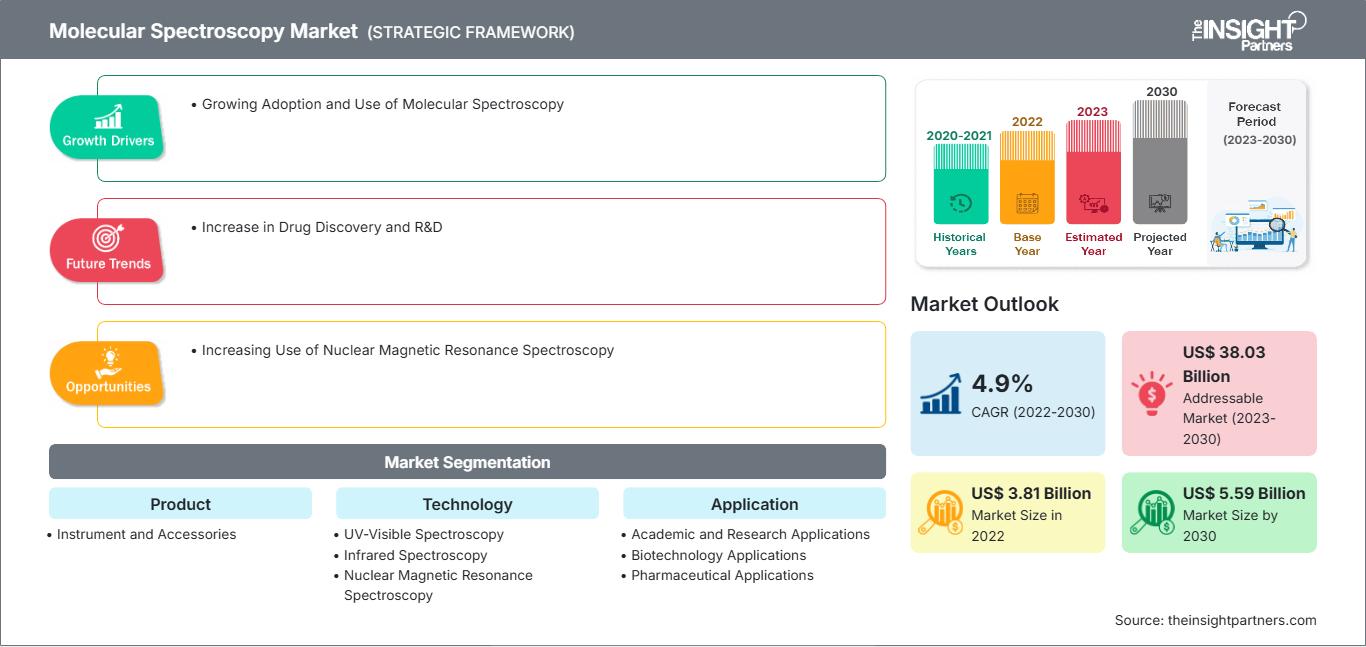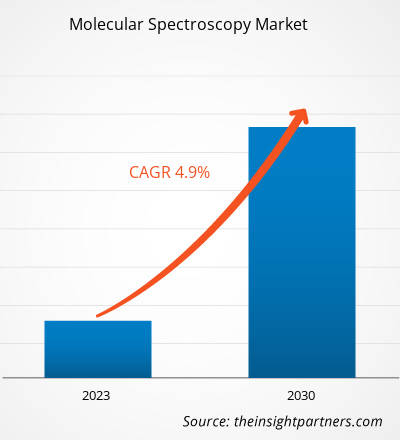[研究报告] 分子光谱市场预计将从 2022 年的 38.073 亿美元增长到 2030 年的 55.8637 亿美元;预计该市场在 2022 年至 2030 年期间的复合年增长率为 4.9%。
市场洞察和分析师观点:
分子光谱市场预测可以帮助该市场的利益相关者规划他们的增长战略。
分子光谱的日益普及和使用以及制药行业的快速增长等因素推动了分子光谱市场的增长。然而,技术熟练的人才短缺以及高昂的维护和安装成本阻碍了市场的增长。
增长动力:
制药行业的快速增长推动了分子光谱市场
近年来,制药行业经历了前所未有的增长速度,预计在未来几年将进一步推进。美国药品研究与制造商协会 (PhRMA) 表示,美国公司承担了全球一半以上的药品研发工作(750 亿美元),并且拥有最多的新药专利。除了发达经济体外,巴西、中国和印度等新兴经济体的研究环境也出现了快速增长。
制药行业的增长对于增加对分子光谱的需求也至关重要。分子光谱技术,包括红外光谱、紫外-可见光谱和质谱,是药物研发最重要的工具之一。近年来,制药行业的显著扩张,主要得益于新冠疫情的爆发,对分子光谱市场规模产生了积极影响。分子光谱在制药行业的主要应用包括分析分子键强度、识别分子中的单个键和特定原子、获取分子特定方向的线索以及分析药物纯度。随着制药公司扩大与药物发现和开发相关的研发活动,对分子光谱的需求也显著增长。例如,拉曼光谱用于研究结构活性和相互作用,以改进反应条件和制剂筛选,并识别从发现到开发过程中的多晶型和规模化药物化合物等限制因素。
因此,上述因素增加了对分子光谱用于各种治疗药物大规模生产的需求,促进了分子光谱市场份额的扩大。
自定义此报告以满足您的要求
您将免费获得任何报告的定制,包括本报告的部分内容,或国家级分析、Excel 数据包,以及为初创企业和大学提供超值优惠和折扣
分子光谱市场: 战略洞察

-
获取本报告的主要市场趋势。这个免费样本将包括数据分析,从市场趋势到估计和预测。
报告细分和范围:
“分子光谱市场分析”通过考虑以下细分市场进行:产品、技术和应用。
细分分析:
按技术划分,分子光谱市场分为紫外-可见光、红外、核磁共振、拉曼、近红外等。紫外-可见光谱细分市场在 2022 年占据最大市场份额。预计核磁共振光谱细分市场在预测期内的复合年增长率最高,为 6.0%。
紫外-可见 (UV-Vis) 光谱法是一种测量与参考或空白样品相比,样品吸收或透射的紫外或可见光不同波长的数量的程序。紫外可见光谱法广泛应用于各个科学领域,从细菌培养、药物鉴定、核酸纯度检测和定量,到饮料行业的质量控制和化学研究。
核磁共振 (NMR) 光谱法是一种分析化学方法,用于质量控制和研究,揭示样品的含量、纯度和分子结构。除了分子结构,NMR 光谱法还可以测定相变、构象和构型变化、溶解度和扩散电位。NMR 光谱法在制药行业已广泛应用超过二十五年,用于测定化学样品的结构。如今,NMR 越来越多地被用于解决生物学问题。所使用的技术范围从生物液体 NMR 到灌注器官和整个动物的体内 NMR 光谱法,再到整个动物和人体的 MRI。
分子光谱市场按产品分为仪器和配件。仪器部分在 2022 年占据了更大的市场份额,预计在预测期内将实现 5.1% 的更高复合年增长率。根据工作原理,光谱仪可分为三种主要类型:色散型、基于滤波器的光谱仪和傅里叶变换光谱仪。在过去的几十年里,傅里叶变换光谱仪(FTS 或 FT 光谱仪)已经在许多红外和近红外应用中取代了色散型仪器。干涉仪是每个傅里叶变换光谱仪的核心。最新一代 FT 光谱仪采用各种干涉仪设计。
分子光谱市场按应用分为学术和研究应用、生物技术应用、制药应用和其他应用。学术和研究应用部分在 2022 年占据了最大的市场份额,预计在预测期内将实现 5.4% 的最高复合年增长率。学术和研究机构是分子光谱市场的关键贡献者,尤其是从事生物技术、细胞培养和再生医学工作的机构。这些机构是重要的测试和验证中心,负责细致评估各种产品的生物相容性和可扩展性。
研发机构致力于分子光谱市场的创新、新产品和新技术的推出以及服务的提供。研发对于加速产品推广也至关重要。研发机构的增长主要归因于生物反应器在研究和创新过程中的日益普及。此外,研究机构投入巨资以促进生物工艺的发展,从而推动了市场的增长。
药物研发的新兴趋势加速了分子光谱市场的扩张
在新冠疫情期间,对分子光谱的需求和使用显著增加。2022年7月,布鲁克PhenoRisk推出了PACS RuO,这是一款仅供研究使用的核磁共振(NMR)测试,用于对来自“长期新冠”患者的血液样本进行分子表型研究。 PhenoRisk PACS RuO 测试有望用于探索早期风险因素、监测心血管疾病、II 型糖尿病、炎症和肾功能障碍的纵向恢复情况以及潜在的继发性器官损害。
此外,分子光谱在药物发现和开发中发挥着至关重要的作用。拉曼光谱已被证明是药物发现和药物开发中最强大的分析技术之一。2020 年 9 月,美资华人生物科技公司 Xtalpi 筹集了 3.19 亿美元的资金,用于进一步开发其智能数字药物发现和开发平台 (ID4),该平台包括固体形状选择、预测小分子候选物特性和其他服务。因此,药物发现的进步可能会在未来几年带来新的分子光谱市场趋势。
区域分析:
从地理上看,全球分子光谱市场报告分为北美、欧洲、亚太地区、南美和中美洲以及中东和非洲。 2022 年,北美占据了最大的分子光谱市场份额。该地区市场的增长得益于生物技术和生物制药公司推出的产品数量的增加以及主要市场参与者的存在。此外,预计各制药和生物技术公司以及学术和研究机构的广泛研发将刺激北美分子光谱市场的增长。
美国是北美市场的最大贡献者。这主要得益于不断增长的生物制药行业,该行业的特点是技术进步和灵活性不断提高。根据国际贸易管理局 (ITA) 的数据,美国是全球生物制药研发领域的领导者。由于监管机构批准的新分子实体 (NME) 数量不断增加,以及众多市场参与者提供新产品,新生物制剂取得了重大进展,这有助于创造新的市场趋势。据《化学与工程新闻》报道,美国食品药品监督管理局 (FDA) 每年批准的新分子实体 (NME) 数量都在增加。此外,美国制药和生物技术公司为改善临床试验结果和确保患者安全而增加研发投入,这也刺激了市场增长。
在加拿大,许多制药公司在全球市场上提供创新产品,这增强了分子光谱市场的增长。在加拿大运营的此类公司包括安进 (Amgen)、Xenon Pharmaceuticals、Zymeworks、吉利德科学 (Gilead Sciences)、雅培 (Abbott)、Alphora Research、安进 (Amgen)、Apotex、安斯泰来 (Astellas)、默克 (Merck)、艾伯维 (AbbVie)、百时美施贵宝 (Bristol-Myers Squibb)、Caprion Biosciences、Charles River Laboratories、葛兰素史克 (GlaxoSmithKline)、Pharma、阿斯利康 (AstraZeneca)、百特 (Baxter)、拜耳 (Bayer) 和 Cipher Pharmaceuticals。
生物制药行业在加拿大的卫生研究和创新生态系统中至关重要。此外,制药公司通过合作开展的广泛研发活动也引发了对中小企业 (SME) 和风险基金的额外投资。此外,为加拿大和国际客户提供服务的合同研究组织 (CRO) 和合同制造组织 (CMO) 数量不断增加,扩大了加拿大制药行业的覆盖范围,从而对市场增长产生了积极影响。2021 年 8 月,加拿大政府宣布与领先的新冠疫苗开发商 Moderna, Inc. 达成协议,将在加拿大建立 mRNA 疫苗生产设施。近期宣布的生物制造和生命科学战略的目标与 Moderna 在加拿大建立 mRNA 疫苗生产设施的努力相一致。此举将增强加拿大的工业能力,并促进生物制造和生命科学产业的发展。
分子光谱市场区域洞察
The Insight Partners 的分析师已详尽阐述了预测期内影响分子光谱市场的区域趋势和因素。本节还讨论了北美、欧洲、亚太地区、中东和非洲以及南美和中美洲的分子光谱市场细分和地域分布。
分子光谱市场报告范围
| 报告属性 | 细节 |
|---|---|
| 市场规模 2022 | US$ 3.81 Billion |
| 市场规模 2030 | US$ 5.59 Billion |
| 全球复合年增长率 (2022 - 2030) | 4.9% |
| 历史数据 | 2020-2021 |
| 预测期 | 2023-2030 |
| 涵盖的领域 |
By 产品
|
| 覆盖地区和国家 |
北美
|
| 市场领导者和主要公司简介 |
|
分子光谱市场参与者密度:了解其对商业动态的影响
分子光谱市场正在快速增长,这得益于终端用户需求的不断增长,而这些需求的驱动因素包括消费者偏好的演变、技术进步以及对产品优势的认知度的提升。随着需求的增长,企业正在扩展产品线,不断创新以满足消费者需求,并抓住新兴趋势,从而进一步推动市场增长。

- 获取 分子光谱市场 主要参与者概述
行业发展和未来机遇:
以下列出了分子光谱市场领先企业的一些战略发展:
- 2023 年 3 月,NJ Biopharmaceuticals LLC 和 JEOL Ltd. 宣布合作,利用 JEOL 的 800 MHz NMR 带来创新药物发现平台解决方案。 NJ Bio 贡献其在抗体-药物偶联物、寡核苷酸偶联物和其他化学领域的专业知识,为其药物研发客户开发平台解决方案——特别是一个利用 NMR 衍生结构信息优化靶向蛋白降解剂 (TPD) 的平台。
- 2023 年 12 月,生命和材料研究的 NMR 波谱解决方案主要由布鲁克公司提供,该公司宣布在俄亥俄州立大学的国家网关超高场 NMR 中心成功安装了一台 1.2 GHz NMR 系统。1.2 GHz AVANCE NMR 波谱仪是能够进行高分辨率液态和固态 NMR 研究的现代化设备。俄亥俄州立大学和美国各地的研究人员将使用它来研究生物分子。结构和动力学以及尖端材料(例如电池中使用的材料)的研究,以更好地了解癌症、心脏病、病毒感染和阿尔茨海默病等疾病的根本原因。
- 2023 年 12 月,精密仪器、测量仪器和医疗设备的领先制造商岛津公司发布了 IRSpirit-X 系列傅里叶变换红外 (FTIR) 光谱仪,包括 IRSpirit-LX、IRSpirit-TX 和 IRSpirit-ZX。入门级 IRSpirit-LX 和 IRSpirit-TX 拥有小型 FTIR*3 中最高的灵敏度,而 IRSpirit-ZX 由于采用了更耐潮的组件,能够在高温高湿地区进行稳定测量。
- 2023 年 12 月,岛津公司推出了 GCMS-QP2050 四极杆气相色谱质谱联用仪。气相色谱质谱仪 (GC-MS) 通过在原子和分子水平上分离样品来分析其中化学物质的类型和含量。GC-MS 系统用于检测农药和其他受控环境污染物,以及食品和化学产品的质量控制和商业开发。
竞争格局和主要公司:
布鲁克公司 (Bruker Corporation)、日本分光公司 (Jasco Corp)、岛津制作所 (Shimadzu Corp)、日本电子有限公司 (JEOL Ltd)、Teledyne Princeton Instruments Inc、安捷伦科技公司 (Agilent Technologies Inc)、牛津仪器公司 (Oxford Instruments Plc)、Ostec Instruments、Revvity Inc、默克集团 (Merck KGaA)、Silios Technologies SA、赛默飞世尔科技公司 (Thermo Fisher Scientific Inc) 和堀场制作所 (Horiba Ltd) 是分子光谱市场报告中介绍的知名公司。这些公司专注于开发新技术、升级现有产品并扩大其地域覆盖范围,以满足全球日益增长的消费者需求。
- 历史分析(2 年)、基准年、预测(7 年)及复合年增长率
- PEST和SWOT分析
- 市场规模、价值/数量 - 全球、区域、国家
- 行业和竞争格局
- Excel 数据集
近期报告
客户评价
购买理由
- 明智的决策
- 了解市场动态
- 竞争分析
- 客户洞察
- 市场预测
- 风险规避
- 战略规划
- 投资论证
- 识别新兴市场
- 优化营销策略
- 提升运营效率
- 顺应监管趋势






















 获取免费样品 - 分子光谱市场
获取免费样品 - 分子光谱市场